A Fast Two-Dimensional Numerical Method for the Wake Simulation of a Vertical Axis Wind Turbine
Abstract
1. Introduction
2. Comparison and Analysis of Numerical Methods for Wake Simulation
3. Methodology
3.1. Finite Vortex Method
3.2. Vortex Particle Method
3.2.1. Discretization of the Circulation
3.2.2. Vorticity Transport Equation
3.2.3. The Calculation of the Velocity of Vortex Particles
3.2.4. The Calculation of the Vorticity of Vortex Particles
3.2.5. The Calculation of the Turbulent Viscosity Coefficient
3.2.6. The Redistribution of the Vortex Particles
3.3. Discrete Parameters and Relevant Convergence Criteria
3.4. The Three-Dimensional Effect Correction Model of Wake
4. Validation and Discussion
5. Conclusions
Author Contributions
Funding
Conflicts of Interest
References
- Wiser, R.; Jenni, K.; Seel, J.; Baker, E.; Hand, M.; Lantz, E.; Smith, A. Expert elicitation survey on future wind energy costs. Nat. Energy 2016, 1, 16135. [Google Scholar] [CrossRef]
- Paraschivoiu, I. Wind Turbine Design: With Emphasis on Darrieus Concept; Presses Inter Polytechnique: Montréal, QC, Canada, 2002. [Google Scholar]
- Araya, D.B.; Craig, A.E.; Kinzel, M.; Dabiri, J.O. Low-order modeling of wind farm aerodynamics using leaky Rankine bodies. J. Renew. Sustain. Energy 2014, 6, 063118. [Google Scholar] [CrossRef]
- Dabiri, J.O. Potential order-of-magnitude enhancement of wind farm power density via counter-rotating vertical-axis wind turbine arrays. J. Renew. Sustain. Energy 2011, 3, 043104. [Google Scholar] [CrossRef]
- Tescione, G.; Ragni, D.; He, C.; Ferreira, C.S.; Van Bussel, G. Near wake flow analysis of a vertical axis wind turbine by stereoscopic particle image velocimetry. Renew. Energy 2014, 70, 47–61. [Google Scholar] [CrossRef]
- Somoano, M.; Huera-Huarte, F. Flow dynamics inside the rotor of a three straight bladed cross-flow turbine. Appl. Ocean Res. 2017, 69, 138–147. [Google Scholar] [CrossRef]
- Araya, D.B.; Dabiri, J.O. A comparison of wake measurements in motor-driven and flow-driven turbine experiments. Exp. Fluids 2015, 56, 150. [Google Scholar] [CrossRef]
- Peng, H.; Lam, H.-F.; Lee, C. Investigation into the wake aerodynamics of a five-straight-bladed vertical axis wind turbine by wind tunnel tests. J. Wind. Eng. Ind. Aerodyn. 2016, 155, 23–35. [Google Scholar] [CrossRef]
- Ouro, P.; Runge, S.; Luo, Q.; Stoesser, T. Three-dimensionality of the wake recovery behind a vertical axis turbine. Renew. Energy 2019, 133, 1066–1077. [Google Scholar] [CrossRef]
- Rolin, V.F.-C.; Porté-Agel, F. Experimental investigation of vertical-axis wind-turbine wakes in boundary layer flow. Renew. Energy 2018, 118, 1–13. [Google Scholar] [CrossRef]
- Rolin, V.; Porté-Agel, F. Wind-tunnel study of the wake behind a vertical axis wind turbine in a boundary layer flow using stereoscopic particle image velocimetry. J. Phys. Conf. Ser. 2015, 625, 012012. [Google Scholar] [CrossRef]
- Ryan, K.J.; Coletti, F.; Elkins, C.J.; Dabiri, J.O.; Eaton, J.K. Three-dimensional flow field around and downstream of a subscale model rotating vertical axis wind turbine. Exp. Fluids 2016, 57, 38. [Google Scholar] [CrossRef]
- Liu, W.; Liu, W.; Zhang, L.; Sheng, Q.; Zhou, B. A numerical model for wind turbine wakes based on the vortex filament method. Energy 2018, 157, 561–570. [Google Scholar] [CrossRef]
- Bachant, P.; Wosnik, M. Reynolds Number Dependence of Cross-Flow Turbine Performance and Near-Wake Characteristics. APS, A13-006. 2014. Available online: http://vtechworks.lib.vt.edu/handle/10919/49210 (accessed on 25 October 2020).
- Chamorro, L.P.; Arndt, R.E.A.; Sotiropoulos, F. Reynolds number dependence of turbulence statistics in the wake of wind turbines. Wind. Energy 2012, 15, 733–742. [Google Scholar] [CrossRef]
- Polagye, B.; Cavagnaro, R.; Niblick, A.; Hall, T.; Thomson, J.; Aliseda, A. Cross-flow turbine performance and wake characterization. In Proceedings of the 1st Marine Energy Technology Symposium (METS13), Washington, DC, USA, 10–11 April 2013. [Google Scholar]
- Du, L.; Ingram, G.; Dominy, R.G. A review of H-Darrieus wind turbine aerodynamic research. Proc. Inst. Mech. Eng. Part C J. Mech. Eng. Sci. 2019, 233, 7590–7616. [Google Scholar] [CrossRef]
- Wang, L.; Zhang, L.; Zeng, N. A potential flow 2-D vortex panel model: Applications to vertical axis straight blade tidal turbine. Energy Convers. Manag. 2007, 48, 454–461. [Google Scholar] [CrossRef]
- Jiang, J.; Ju, Q.; Yang, Y. Finite Element Vortex Method for Hydrodynamic Analysis of Vertical Axis Cycloidal Tidal Turbine. J. Coast. Res. 2019, 93, 988–997. [Google Scholar] [CrossRef]
- Li, G.; Chen, Q.; Gu, H. An Unsteady Boundary Element Model for Hydrodynamic Performance of a Multi-Blade Vertical-Axis Tidal Turbine. Water 2018, 10, 1413. [Google Scholar] [CrossRef]
- Zou, F.; Riziotis, V.A.; Voutsinas, S.G.; Wang, J. Analysis of vortex-induced and stall-induced vibrations at standstill conditions using a free wake aerodynamic code. Wind. Energy 2014, 18, 2145–2169. [Google Scholar] [CrossRef]
- Abedi, H.; Davidson, L.; Voutsinas, S. Numerical Studies of the Upstream Flow Field Around a Horizontal Axis Wind Turbine. In Proceedings of the 33rd Wind Energy Symposium, Kissimmee, FL, USA, 5–9 January 2015; p. 0495. [Google Scholar] [CrossRef]
- Kamemoto, K.; Zhu, B.; Ojima, A. Attractive features of an advanced vortex method and its subjects as a tool of lagrangian LES. In Proceedings of the 14th Japan Society of CFD Symposium, Japan, 1 September 2000; pp. 1–10. Available online: https://www.researchgate.net/publication/237476008_zuixinwofanozhumusubekitexingtoraguranjuLES_fatoshitenoketi_Attractive_Features_of_an_Advanced_Vortex_Method_and_its_Subjects_as_a_Tool_of_Lagrangian_LES (accessed on 25 October 2020).
- Dyachuk, E.; Goude, A. Numerical Validation of a Vortex Model against ExperimentalData on a Straight-Bladed Vertical Axis Wind Turbine. Energies 2015, 8, 11800–11820. [Google Scholar] [CrossRef]
- Zuo, W.; Wang, X.; Kang, S. Numerical simulations on the wake effect of H-type vertical axis wind turbines. Energy 2016, 106, 691–700. [Google Scholar] [CrossRef]
- Ouro, P.; Stoesser, T. An immersed boundary-based large-eddy simulation approach to predict the performance of vertical axis tidal turbines. Comput. Fluids 2017, 152, 74–87. [Google Scholar] [CrossRef]
- Li, Y. Development of a Procedure for Power Generated from a Tidal Current Turbine Farm. Ph.D. Thesis, University of British Columbia, Vancouver, BC, Canada, 2008. [Google Scholar]
- Mendoza, V. Aerodynamic Studies of Vertical Axis Wind Turbines Using the Actuator Line Model. Ph.D. Thesis, Acta Universitatis Upsaliensis, Uppsala, Sweden, 2018. [Google Scholar]
- Hu, H.; Gu, B.; Zhang, H.; Song, X.; Zhao, W. Hybrid Vortex Method for the Aerodynamic Analysis of Wind Turbine. Int. J. Aerosp. Eng. 2015, 2015, 650868. [Google Scholar] [CrossRef]
- Nguyen, D.V.; Jansson, J.; Goude, A.; Hoffman, J. Direct Finite Element Simulation of the turbulent flow past a vertical axis wind turbine. Renew. Energy 2019, 135, 238–247. [Google Scholar] [CrossRef]
- Grondeau, M.; Guillou, S.; Mercier, P.; Poizot, E. Wake of a Ducted Vertical Axis Tidal Turbine in Turbulent Flows, LBM Actuator-Line Approach. Energies 2019, 12, 4273. [Google Scholar] [CrossRef]
- Griffith, D.T.; Barone, M.F.; Paquette, J.; Owens, B.C.; Bull, D.L.; Simao-Ferriera, C.; Goupee, A.; Fowler, M. Design Studies for Deep-Water Floating Offshore Vertical Axis Wind Turbines; Sandia National Lab. (SNL-NM): Albuquerque, NM, USA, 2018. [Google Scholar]
- Li, Y.; Calisal, S.M. Three-dimensional effects and arm effects on modeling a vertical axis tidal current turbine. Renew. Energy 2010, 35, 2325–2334. [Google Scholar] [CrossRef]
- Whittlesey, R.W.; Liska, S.; Dabiri, J.O. Fish schooling as a basis for vertical axis wind turbine farm design. Bioinspir. Biomim. 2010, 5, 035005. [Google Scholar] [CrossRef]
- Gao, X.; Yang, H.; Lu, L. Optimization of wind turbine layout position in a wind farm using a newly-developed two-dimensional wake model. Appl. Energy 2016, 174, 192–200. [Google Scholar] [CrossRef]
- Abkar, M. Theoretical Modeling of Vertical-Axis Wind Turbine Wakes. Energies 2018, 12, 10. [Google Scholar] [CrossRef]
- Zanforlin, S.; DeLuca, S. Effects of the Reynolds number and the tip losses on the optimal aspect ratio of straight-bladed Vertical Axis Wind Turbines. Energy 2018, 148, 179–195. [Google Scholar] [CrossRef]
- Siddiqui, M.S.; Durrani, N.; Akhtar, I. Quantification of the effects of geometric approximations on the performance of a vertical axis wind turbine. Renew. Energy 2015, 74, 661–670. [Google Scholar] [CrossRef]
- Boudreau, M.; Dumas, G. Comparison of the wake recovery of the axial-flow and cross-flow turbine concepts. J. Wind. Eng. Ind. Aerodyn. 2017, 165, 137–152. [Google Scholar] [CrossRef]
- La Mantia, M.; Dabnichki, P. Unsteady panel method for flapping foil. Eng. Anal. Bound. Elements 2009, 33, 572–580. [Google Scholar] [CrossRef]
- Satyanarayana, B.; Davis, S. Experimental Studies of Unsteady Trailing-Edge Conditions. AIAA J. 1978, 16, 125–129. [Google Scholar] [CrossRef]
- Ho, C.M.; Chen, S.H. Unsteady Kutta condition of a plunging airfoil. In Unsteady Turbulent Shear Flows; Springer: Berlin/Heidelberg, Germany, 1981; pp. 197–206. [Google Scholar]
- Liebe, R. Unsteady flow mechanisms on airfoils: The extended finite vortex model with applications. Flow Phenom. Nat. 2007, 1, 283–339. [Google Scholar]
- Vatistas, G.H.; Kozel, V.; Mih, W.C. A simpler model for concentrated vortices. Exp. Fluids 1991, 11, 73–76. [Google Scholar] [CrossRef]
- Liu, Y. Fast Multipole Boundary Element Method: Theory and Applications in Engineering; Cambridge University Press: Cambridge, UK, 2009. [Google Scholar]
- Stock, M.J. Summary of Vortex Methods Literature (a Living Document Rife with Opinion). 2007. Available online: http://citeseerx.ist.psu.edu/viewdoc/summary?doi=10.1.1.133.1239 (accessed on 25 October 2020).
- Winckelmans, G.S. Vortex Methods. In Encyclopedia of Computational Mechanics; Chapter 5; American Cancer Society: Atlanta, GA, USA, 2004; Volume 1, Available online: https://onlinelibrary.wiley.com/doi/book/10.1002/0470091355 (accessed on 25 October 2020).
- Winckelmans, G.; Leonard, A. Contributions to Vortex Particle Methods for the Computation of Three-Dimensional Incompressible Unsteady Flows. J. Comput. Phys. 1993, 109, 247–273. [Google Scholar] [CrossRef]
- Mansfield, J.R.; Knio, O.M.; Meneveau, C. A Dynamic LES Scheme for the Vorticity Transport Equation: Formulation anda PrioriTests. J. Comput. Phys. 1998, 145, 693–730. [Google Scholar] [CrossRef]
- Sagaut, P. Large Eddy Simulation for Incompressible Flows: An Introduction; Springer Science & Business Media: New York, NY, USA, 2006. [Google Scholar]
- Koumoutsakos, P.D. Direct Numerical Simulations of Unsteady Separated Flows Using Vortex Methods. California Institute of Technology, 1993.1.1. Available online: https://www.researchgate.net/publication/225304763_Direct_numerical_simulations_of_unsteady_separated_flows_using_vortex_methodsPh_D_Thesis (accessed on 25 October 2020).
- Marsh, P.; Ranmuthugala, D.; Penesis, I.; Thomas, G. The influence of turbulence model and two and three-dimensional domain selection on the simulated performance characteristics of vertical axis tidal turbines. Renew. Energy 2017, 105, 106–116. [Google Scholar] [CrossRef]
- Bachant, P.; Goude, A.; Wosnik, M. Actuator line modeling of vertical-axis turbines. arXiv 2016, arXiv:1605.01449. [Google Scholar]
- Papadakis, G. Development of a Hybrid Compressible Vortex Particle Method and Application to External Problems including Helicopter Flows. Ph.D. Thesis, National Technical University of Athens, Athens, Greece, 2014. [Google Scholar]
- Beale, J.; Majda, A. Vortex methods. I. Convergence in three dimensions. Math. Comput. 1982, 39, 1–27. [Google Scholar]
- Wang, Y.; Abdel-Maksoud, M. Application of the remeshed vortex method to the simulation of 2D flow around circular cylinder and foil. Ship Technol. Res. 2018, 65, 79–86. [Google Scholar] [CrossRef]
- Araya, D.B.; Colonius, T.; Dabiri, J.O. Transition to bluff-body dynamics in the wake of vertical-axis wind turbines. J. Fluid Mech. 2017, 813, 346–381. [Google Scholar] [CrossRef]
- Tordella, D.; Scarsoglio, S. The first Rcr as a possible measure of the entrainment length in a 2D steady wake. Phys. Lett. A 2009, 373, 1159–1164. [Google Scholar] [CrossRef][Green Version]
- Wang, L.; Zhou, Y.; Xu, J. Optimal Irregular Wind Farm Design for Continuous Placement of Wind Turbines with a Two-Dimensional Jensen-Gaussian Wake Model. Appl. Sci. 2018, 8, 2660. [Google Scholar] [CrossRef]
- Sun, H.; Yang, H. Numerical investigation of the average wind speed of a single wind turbine and development of a novel three-dimensional multiple wind turbine wake model. Renew. Energy 2020, 147, 192–203. [Google Scholar] [CrossRef]
- Ouro, P.; Stoesser, T. Wake Generated Downstream of a Vertical Axis Tidal Turbine. In Proceedings of the 12th European Wave and Tidal Energy Conference, Cork, Ireland, 27 August–1 September 2017. [Google Scholar]
- Zanforlin, S.; Nishino, T. Fluid dynamic mechanisms of enhanced power generation by closely spaced vertical axis wind turbines. Renew. Energy 2016, 99, 1213–1226. [Google Scholar] [CrossRef]

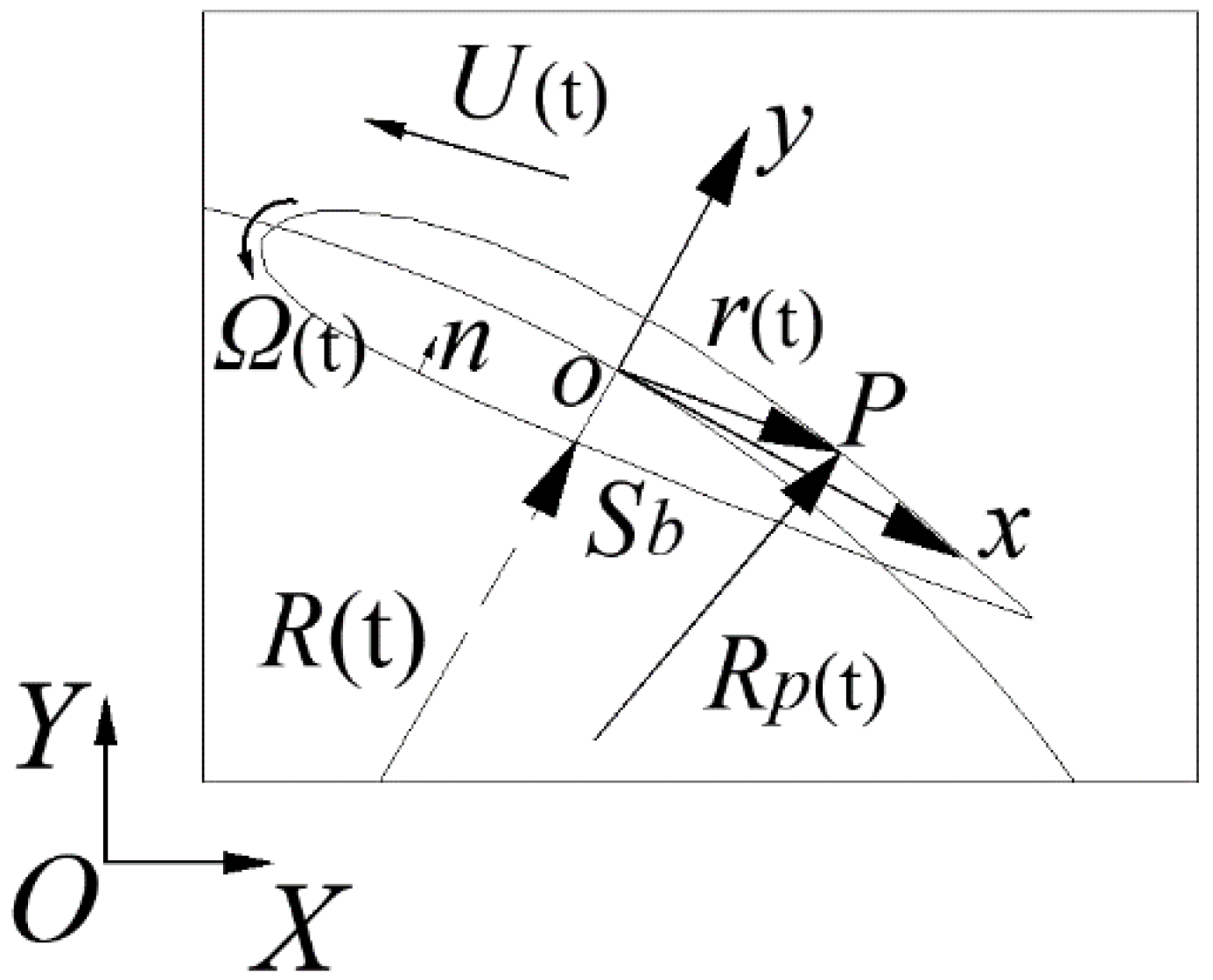
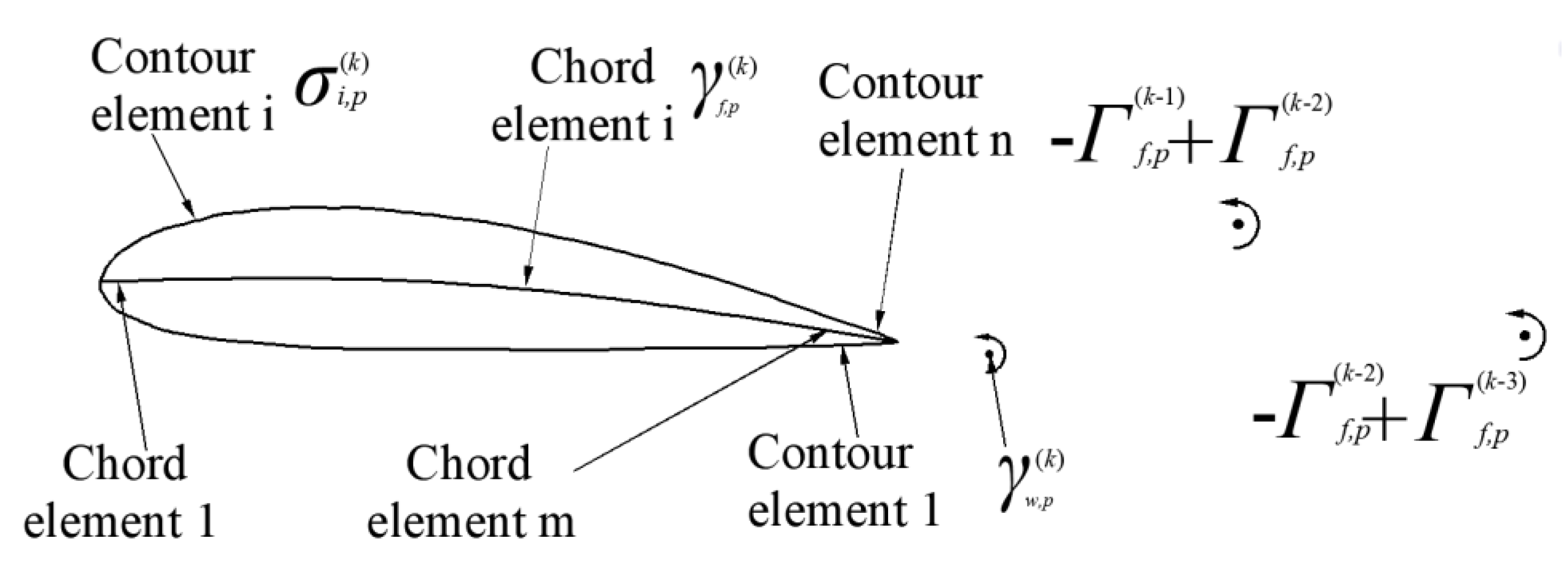
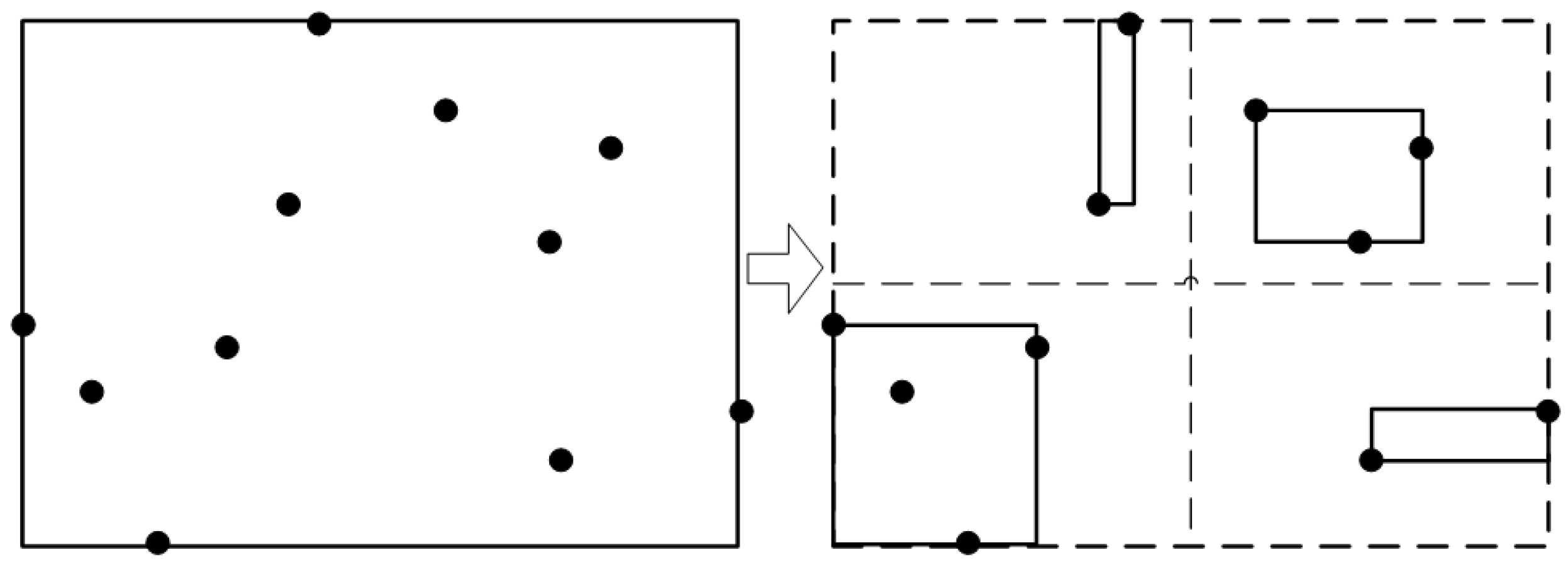
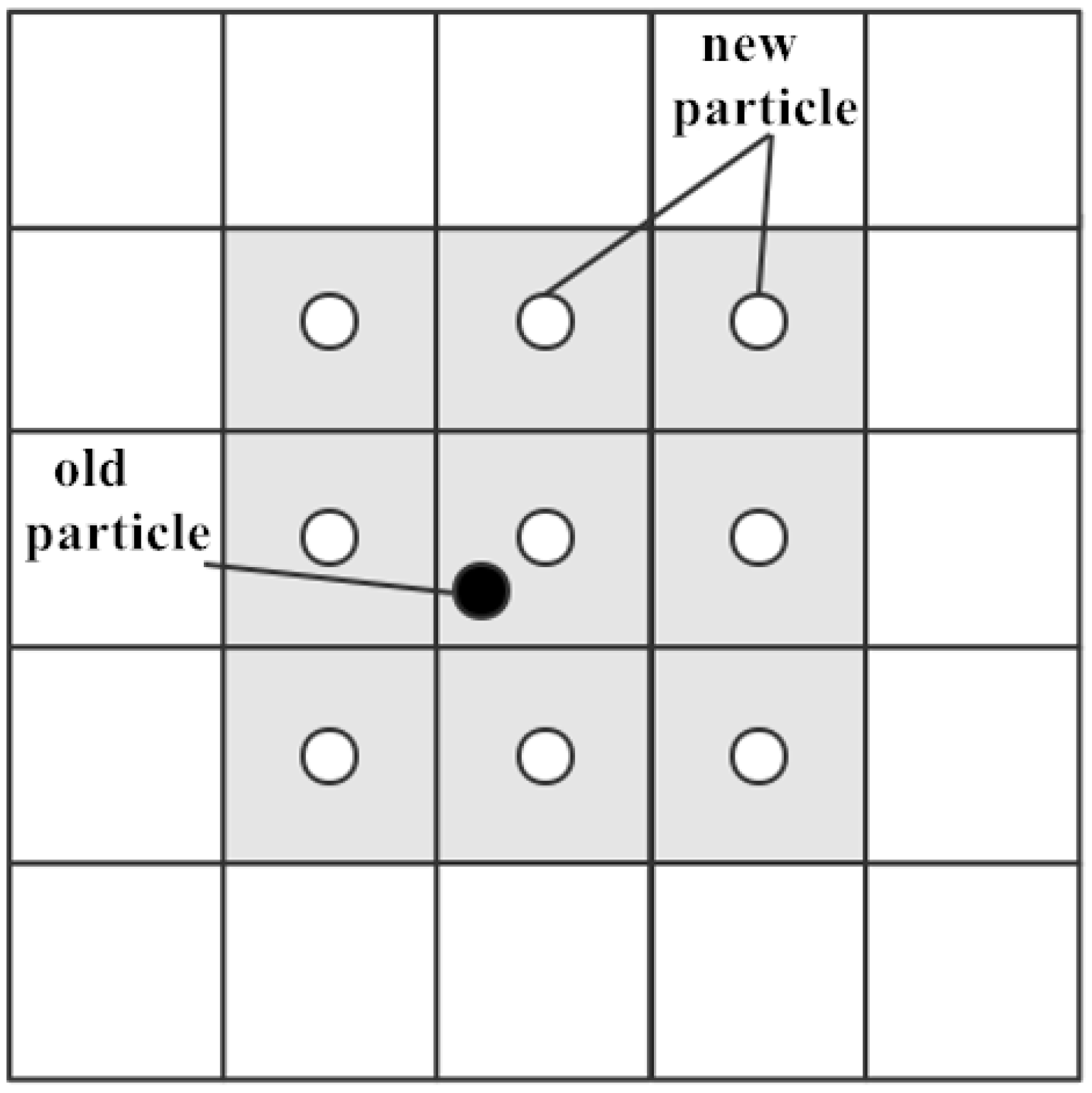
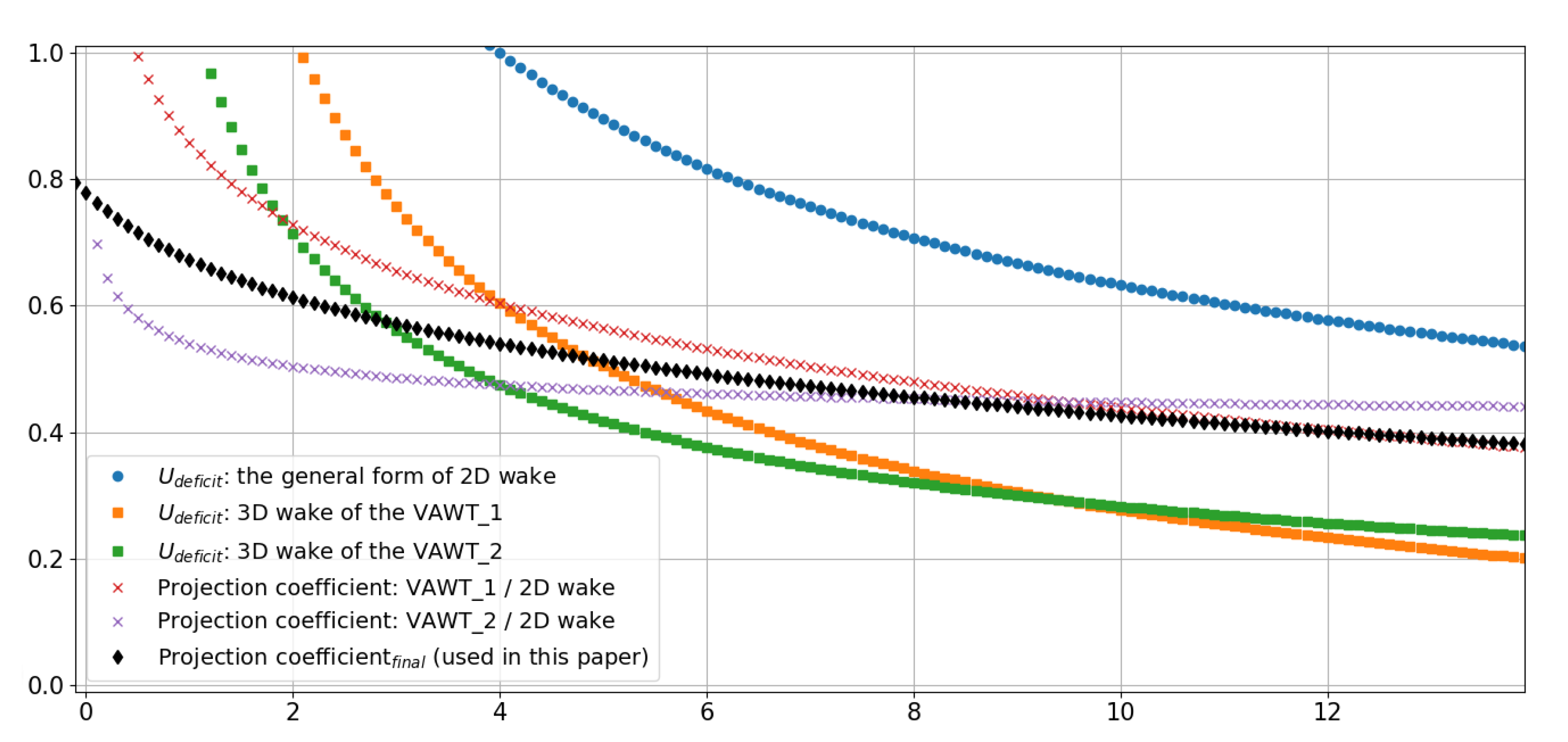


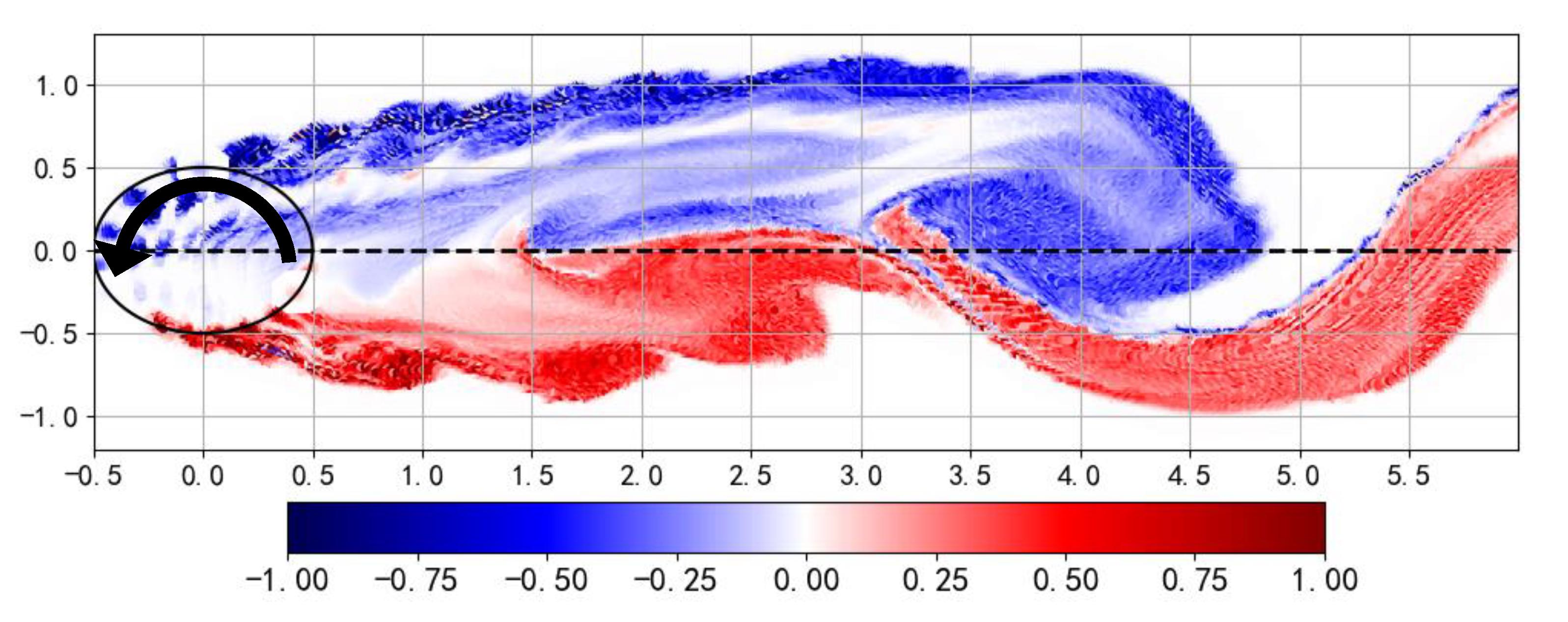
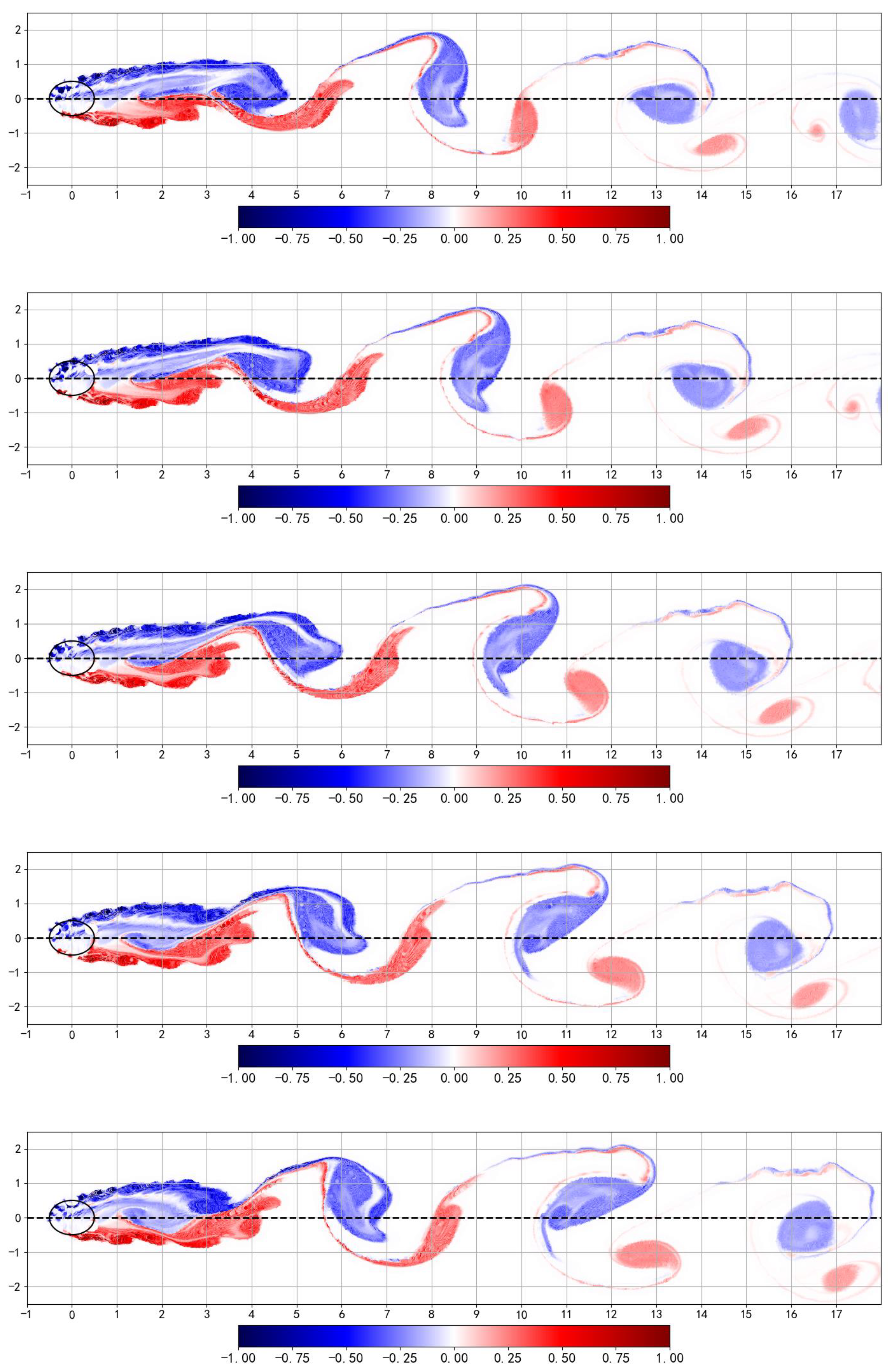
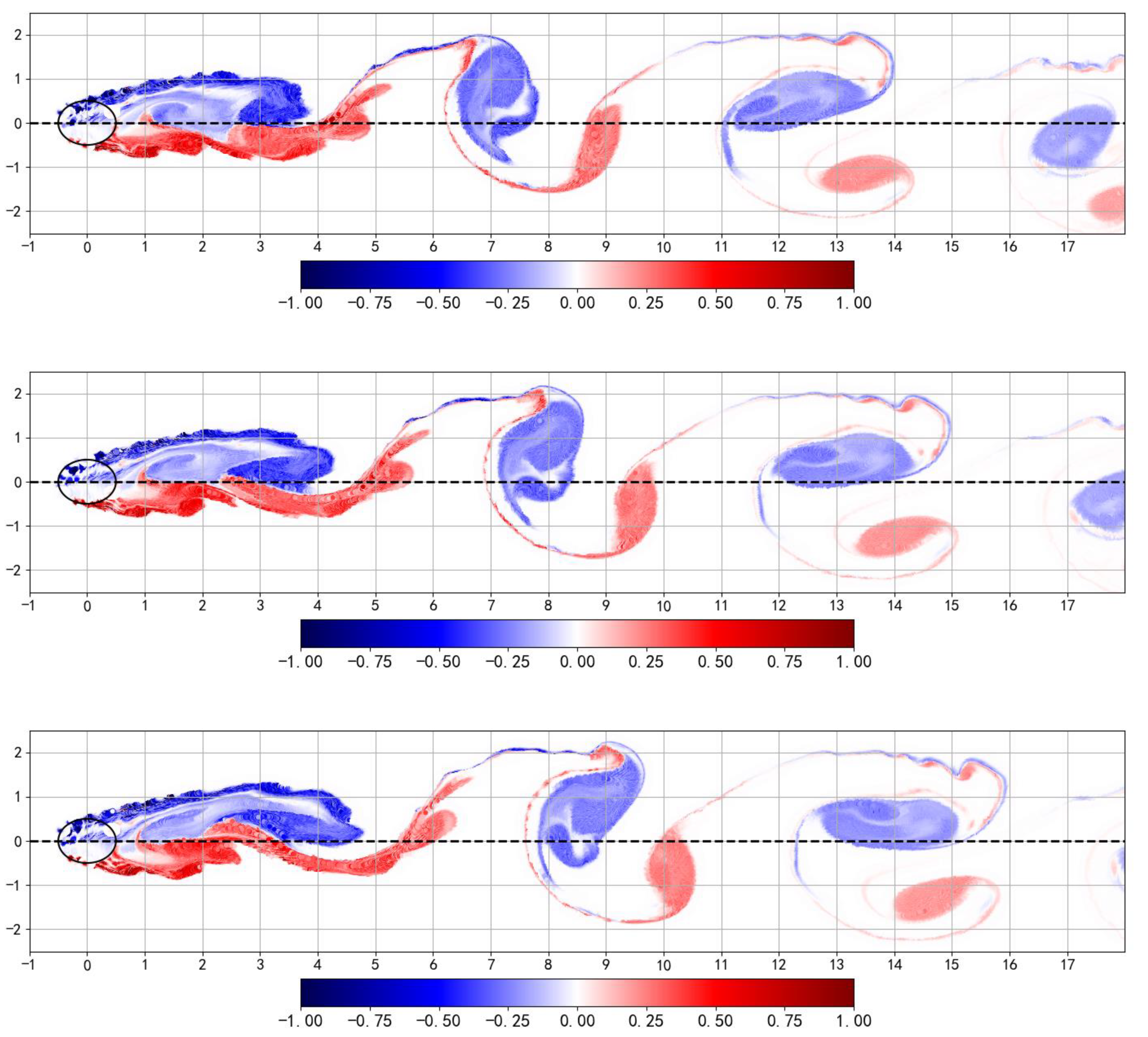
| Main Category | The Description of Corresponding Submethods |
|---|---|
| The first step: How to calculate the blade load? | 1S—Streamtube method: The single streamtube model can be used to calculate the performance of the whole rotor, while the multiple streamtube models can be used to calculate the blade load at different azimuthal angles. The influence of upstream on downstream can be considered in the double multiple streamtube model [2]. 1 V—Vortex Panel method: Based on the Kelvin theorem, the blade forces and vortex shedding at different azimuthal angles can be calculated. According to the types of singularity distribution and the way of the vortex shedding, this method can be further subdivided into many kinds [18,19,20,21,22,23]. The computational efficiency of the potential theory is high, but the results need to be modified at a high angle of attack [19,24]. 1G—Grid-based method: There is the body-fitted grid method [25] and the immersed boundary method [26]. Relatively speaking, the computational accuracy is high, but the computational cost is also high. 1 T—The tabulated data of lift and drag coefficient: It is not necessary to calculate the blade force; only the aerodynamic angle of attack at different azimuthal angles need to be calculated. Then the lift and drag of the blade at the corresponding angle of attack can be obtained by looking up the database table. The lift and drag coefficients were measured at the static state [27] or the dynamic state [24] in wind tunnel experiments. Due to the dependence on the database, it may not be applicable for some new airfoils. |
| The second step: In which form does the blade force affect the flow field? | 2 F—The form of force source term: The force coefficient obtained by numerical calculation or database table can be regarded as the force source term, which should be smoothed by the kernel function and calculated by the grid-based method [28]. 2 V—The form of vorticity source term: The circulation of the bound vortex can be transformed from the force coefficient according to the Kutta–Joukowski law, and the circulation of the shedding vortex can be calculated by the vortex panel method. Then, the circulation will be smoothed into vorticity source terms by the kernel function and calculated by the vortex method [27]. Note: This step does not need to be considered in the streamtube method. |
| The third step: How to simulate the VAT wake? | 3S—Streamtube method: The streamtube method is based on the momentum theory, and the velocity distribution of the VAT wake can be roughly estimated [2]. 3VE—Vortex method with empirical viscosity: In order to produce the equivalent effect of viscous dissipation, an empirical decay function is added into the kernel function of the vorticity source term [27]. 3VA—Vortex method with analytical viscosity: The vorticity source term could be discretized into the vortex particles, and the variation of vorticity caused by the viscous dissipation can be calculated analytically in the vorticity transport equation [29]. 3G—Grid-based method: The evolution of the wake-field can be simulated by some grid-based methods (such as the finite difference method, the finite volume method [25], the Galerkin finite element method [30] and the lattice Boltzmann method [31]). Note: The grid-based method (3G) is in the Eulerian framework, and the vortex method (3VE, 3VA) is a grid-free method in the Lagrangian framework. |
| Airfoil Section | NACA 0018 | Tip Speed Ratio | 1.1 |
|---|---|---|---|
| Chord length | 3 cm | Wind speed at the mid-span | 9.43 m/s |
| Number of blades | 3 | Chord-based Reynolds number | 20,000 |
| Rotor height | 15.5 cm | Inflow condition | Turbulent boundary layer |
| Rotor diameter | 16.6 cm | Experimental condition | Wind tunnel, stereo-PIV |
| Model | Number of Blades | Tip Speed Ratio | Solidity | The Downstream Transition Location | The Power Function of Wake Velocity Deficit |
|---|---|---|---|---|---|
| Benchmark case (two-dimensional wake model) | 3 | 1.1 | 0.172 | Xt ≈ 4D | |
| VAWT_1 [57] (three-dimensional wake model) | 3 | 1.2 | 0.32 | Xt ≈ 1.9D | |
| VAWT_2 [57] (three-dimensional wake model) | 2 | 1.22 | 0.21 | Xt ≈ 2.88D |
Publisher’s Note: MDPI stays neutral with regard to jurisdictional claims in published maps and institutional affiliations. |
© 2020 by the authors. Licensee MDPI, Basel, Switzerland. This article is an open access article distributed under the terms and conditions of the Creative Commons Attribution (CC BY) license (http://creativecommons.org/licenses/by/4.0/).
Share and Cite
Yuan, Z.; Jiang, J.; Zang, J.; Sheng, Q.; Sun, K.; Zhang, X.; Ji, R. A Fast Two-Dimensional Numerical Method for the Wake Simulation of a Vertical Axis Wind Turbine. Energies 2021, 14, 49. https://doi.org/10.3390/en14010049
Yuan Z, Jiang J, Zang J, Sheng Q, Sun K, Zhang X, Ji R. A Fast Two-Dimensional Numerical Method for the Wake Simulation of a Vertical Axis Wind Turbine. Energies. 2021; 14(1):49. https://doi.org/10.3390/en14010049
Chicago/Turabian StyleYuan, Zheng, Jin Jiang, Jun Zang, Qihu Sheng, Ke Sun, Xuewei Zhang, and Renwei Ji. 2021. "A Fast Two-Dimensional Numerical Method for the Wake Simulation of a Vertical Axis Wind Turbine" Energies 14, no. 1: 49. https://doi.org/10.3390/en14010049
APA StyleYuan, Z., Jiang, J., Zang, J., Sheng, Q., Sun, K., Zhang, X., & Ji, R. (2021). A Fast Two-Dimensional Numerical Method for the Wake Simulation of a Vertical Axis Wind Turbine. Energies, 14(1), 49. https://doi.org/10.3390/en14010049







